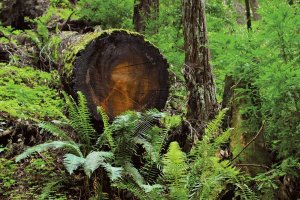

The planet Earth is filled with fascinating and majestic creatures of all shapes and sizes, from large to small, denizens of the animal kingdom never cease to amaze and captivate scientists, writers, and artist. But animals are nothing compared to what the kingdom of plants has to offer. Some plants have colorful flowers, some live in the sea, some are poisonous or carnivorous, but only one can live to be 2000 years old and 115 meters (377 feet) tall – the Sequoia Sempervirens, meaning “forever living”, but they’re commonly called the Coast Redwoods.
Coast Redwoods are Conifers (cone bearing), and like the well-known Pine and Spruce, their leaves are needles, and are kept year round. The west coast of the United States (though they’ve been found all around the country) provides the optimal climate for these massive trees. With moderate year round temperature and humid conditions, these trees flourish in coastal northern California and southern Oregon, but that’s not all – frequent summer fogs play a vital role for the Redwood, which I’ll touch on later.
How do the Coast Redwoods get so big? Water, lots and lots of water. All types of plants on Earth need water, for four basic reasons. Firstly, germination (making seeds), secondly photosynthesis, thirdly nutrient transfer, and lastly transpiration – these actions in trees reaching 100 meters tall require exponentially more water than your average oak.
Having a lot of water isn’t the end of the story though, the larger a plant gets, the more challenging moving water gets. Plants move water and nutrients up from the soil via their roots; this process is called “transpiration”, and is an essential process in the life of a plant. During transpiration a tree moves water from the soil to its branches and leaves via small capillaries called Xylem channels, which for a giants like the Coast Redwood requires a lot of suction. This suction is accomplished by water evaporating from a trees leaves, as the stomata (tiny pores on the underside of a leaf) open to take in carbon dioxide, they allow water to evaporate, said evaporation creates negative pressure within the xylem, and since a system will always strive to be equalized, water is pulled up the tree. There’s a slight problem with this however, at the pressures of -270 PSI measured in redwood trees cold water would normally boil, which is called cavitation. Not to worry though, the Redwoods have evolved to deal with this, as water travels up the xylem, the molecules of sap and water stick together, coupled by the very, very tiny diameter of these micro capillaries, surface tension wins over gravity, pulling a chain of water to the top of the tree.

If that wasn’t an impressive enough system of transporting water to the tree, remember the fog? The daily fog that creeps into the Redwood forest decreases the water loss from transpiration, and keeps the soil moist. Researchers suggest the fog is more important than the areas annual rainfall.
Coast Redwoods have spectacular ability to survive, which is undoubtedly why we find such old specimens in the wild still. When exposed to fire, the bark of a Redwood tree, which is sometimes over a foot thick quickly chars – creating a layer of bark already burned, but still intact to act as a heat shield against the roaring flames of the commonwildfires of the region. Thick bark doesn’t do you any good if you’re a tree that gets knocked over though. Not to worry, when a Redwood falls on its side, if left undisturbed the branches will grow upwards into new trunks, genetically identical to the fallen tree (this is sometimes described as a candelabra tree). We can’t however, forget about the stump of the original tree, often times a Redwood “cathedral” or ring of clones will grow upwards from this stump. Taking clones into account, some redwood trees could be in upwards of 30,000 years old!

Coast Redwoods are SO big that they house their own mini-ecosystems, so far 186 species have been found in the Redwood canopy. Over the centuries decaying matter from the tops of the Redwoods falls down into crevasses between branches, creating soil for other plants and animals to thrive on, hundreds of feet in the air. From hanging ferns, to whole thickets of huckleberry bushes, to tree voles and salamanders, it seems like there’s no limit to the species that can be found up in these giants.
On our ever changing planet it seems that giant mythical trees are a thing of the past, with threat from humans and the climate itself it’s easy to miss some of Earth’s amazing plant life. California’s Coast Redwoods are not immune to deforestation, but it seems they are thriving in an increasingly warming climate with unprecedented growth in recent decades. Redwoods may also be our best defense against rising carbon levels in the atmosphere, holding up to three times more carbon than other forests, the question is not how climate change is affecting the Redwood trees, but how the Redwoods can effect climate change.
Sometimes it’s easy to forget that life is a resilient force that dominates our planet. Through changes in climate, disease, natural disasters, and human interaction, the Sequoia Sempervirens continue to grow and nourish our planet, and provide astonishing beauty in a sometimes ugly world.
